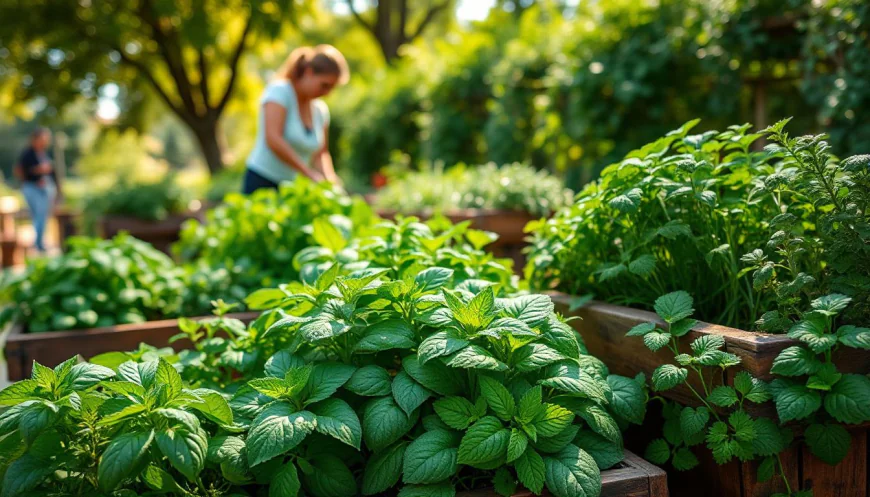The Ultimate Guide to Herbs: Unlocking Nature’s Power for Health, Cooking, and Care
Herbs are making a big comeback. More folks are turning to nature for remedies, flavor, and even beauty tips. These green plants aren’t just pretty—they hold hidden powers that can boost your health, enhance your cooking, and help you feel your best. Whether you want to cook more flavorful meals, try natural medicine, or care for your skin, understanding herbs opens up a world of possibilities.

What Are Herbs? An Introduction to Nature’s Botanical Treasures
Herbs are plants that are valued mainly for their leaves, flowers, or stems. They often pack a punch in flavor, smell, or health benefits. Unlike spices, which come from roots, seeds, or bark, herbs are usually leafy greens. Cultures from Egypt to China have used herbs for thousands of years. Ancient civilizations saw them as magic potions that could cure ailments and bring good luck.
Types of Herbs: Exploring Common and Exotic Varieties
Culinary Herbs
Culinary herbs are the stars of your kitchen. They add flavor to dishes and make food smell and taste amazing. Some favorites include:
- Basil
- Parsley
- Cilantro
- Oregano
Use fresh herbs for vibrant taste, but dried ones work well too—just store them in a cool, dark place. Fresh herbs should be used quickly, while dried herbs last longer if kept properly.
Medicinal Herbs
Medicinal herbs aim to improve health. They can boost immunity, help you relax, or give you a quick energy lift. Popular options are:
- Echinacea for immune support
- Chamomile for calming nerves
- Ginseng to boost energy
These plants have been used for centuries to treat many conditions. Modern science keeps uncovering new benefits from these traditional remedies.
Aromatic and Ornamental Herbs
Some herbs smell great and look beautiful in gardens. They also have relaxing properties. Examples include:
- Lavender
- Rosemary
- Thyme
Besides decorating your space, these herbs can be used in aromatherapy, bath products, or simply to provide a calming scent at home.
Growing and Harvesting Herbs: A Guide to Cultivation and Sustainability
How to Grow Herbs at Home
Growing herbs is easier than you think. Start by choosing well-drained soil and a spot that gets plenty of sunlight. Herbs like basil and cilantro love warm weather. If you don’t have a yard, use pots on balconies or windowsills. Small containers can yield big flavor with minimal effort.
Harvesting and Preserving
Knowing the right time to pick herbs matters. Usually, harvest leaves in the morning when they’re most flavorful. Cut flowers and roots carefully when mature. Keep your herbs fresh by drying them in a cool space, freezing leaves in ice cubes, or making herbal teas and infusions.
Sustainable Herb Gardening
For eco-friendly herb growing, choose organic methods. Avoid chemicals that can harm beneficial bugs. Plant a variety of herbs to attract bees and butterflies. This helps your garden stay healthy and productive for years.
Health Benefits and Uses of Herbs
Herbs in Traditional Medicine
Ancient systems like Ayurveda, Chinese medicine, and Western herbalism all have stories of herbs healing injuries and illnesses. For example, ginger helps with digestion, and calendula promotes skin healing.
Modern Scientific Research
Today, many herbs have scientific proof backing their benefits. They contain antioxidants that fight free radicals. Some, like garlic and honey, show antimicrobial effects in studies. Scientific trials continue to support what traditional healers have known for centuries.
Incorporating Herbs into Daily Life
You don’t need to be a chef or a herbalist to enjoy herbs. Brew a cup of herbal tea, take a tincture, or use herbal supplements with your meals. Baking with herbs adds flavor naturally and cuts down on salt or artificial flavorings.
Culinary Uses of Herbs: Enhancing Flavor and Nutrition
Popular Herb Combinations
Classic pairings bring dishes alive. Think basil with tomatoes or rosemary with lamb. Mixing herbs like parsley, thyme, and dill creates flavorful blends for salads, marinades, and sauces.
Cooking Tips and Recipes
Add herbs toward the end of cooking to preserve their flavors. Fresh herbs brighten up a dish, while dried herbs work excellent in slow-cooked recipes. Try new recipes and see how herbs can change everyday meals.
Using Herbs for Dietary Restrictions
Herbs are great for flavor without extra salt or sugar. Use herb-infused oils and vinegars to prepare dressings or marinades that fit special diets. They’re flavor powerhouses, especially if you’re watching your sodium intake.
Personal Care and Wellness with Herbs
Herbal Skincare and Haircare
Many herbs work wonders on skin. Calendula calms redness, and chamomile soothes irritated skin. You can make your own herbal masks or shampoos at home, using simple ingredients.
Aromatherapy and Relaxation
Herb-based essential oils—like lavender and eucalyptus—are perfect for calming your mind and reducing stress. Create your own relaxing space with herbal scents, or use diffusers to enjoy their benefits all day long.
Herbal Supplements and Remedies
Choosing quality herbal supplements ensures safety and effectiveness. Always read labels and talk to a healthcare professional if you’re unsure. Remember, herbs can be powerful, so use them responsibly.
Conclusion
Herbs have played a vital role throughout history—whether in cooking, healing, or caring for ourselves. By growing your own herbs, using them wisely, and respecting their power, you can boost your health and add flavor to life. Exploring herbs is a simple way to embrace a more natural, holistic lifestyle.
Key Takeaways
- Herbs are versatile plants that impact health, food, and beauty.
- Growing and harvesting them the right way boosts their benefits.
- Incorporating herbs daily can improve your health and mood.
- Living sustainably supports both your well-being and the planet.
Start experimenting with herbs today—you might just find your new favorite plant!



 VARSHITHA
VARSHITHA